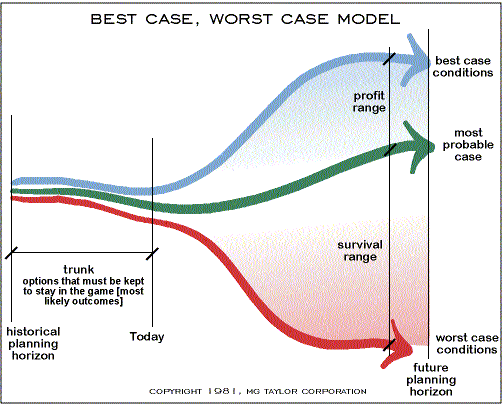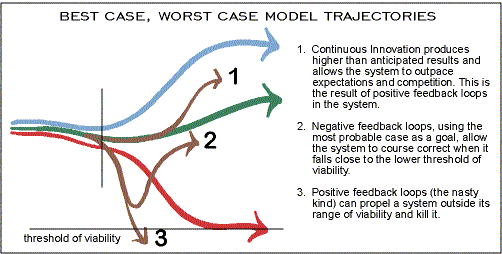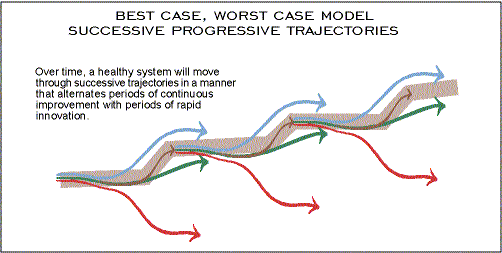
|
|
Like the other models of the MG Taylor Modeling Language, the Best Case Worst Case Model is protected by copyright. You can use it only by meeting these four conditions. The future, they say, holds infinite potential. Unfortunately, that does not particularly help us plan ahead. The Best Case / Worst Case model can assist us by creating an "envelope of possibility" for the future of a condition, project or venture. By envisioning the complete range of possible outcomes (and the paths to reach those outcomes), we can more readily understand the implications of our decisions and the value of our current resources. The basic model, as always, seems fairly straightforward. We stand at the mouth of the "Trunk", at the moment when the future branches out in front of us in all of its unpredictability. The Trunk behind us represents the past, including all of the experiences that we have had and all of the resources currently at our disposal. From this vantage point, we can now set some limits on our future.
What lies between the Best Case and Worst Case paths is the field of opportunity. Between Best Case and Most Probable Case lies the Profit Range. Between Most Probable and Worst Case is the Survival Range (albeit not necessarily a pleasant survival). Outside this envelope (either better than best or worse than worst) lies the Collapse and Death options from Stages of an Enterprise. The Dynamic Model Secondly, in its dynamic form, we are always located at the mouth of the Trunk. That moment is the present, and the field of opportunity is always opening anew before us. This means that the only time we can ever ACT on the model is at the mouth of the Trunk, for that is the only place at which we find ourselves. The corollary to that is that NOW is the only time we can act to influence the system. This is the greatest opportunity we have. From this vantage point, it becomes clear that EVERY action must be aligned and true. Every action must bring "There" to "Here". "Easy" actions that do not take us towards our goal (the Best Case) lead us quite clearly towards our Worst Case or even outside of the scope of the model--towards Death.
Systems navigating through the model over time encounter several recurring patterns of behavior. Rarely will a system traverse the exact path of the most probable case. First of all, that case, being a projection, will change over time. Second, living organisms are cybernetic systems that use hunting and goal seeking methods to stay on track. These methods involve lag times which cause the system to oscillate about the goal. The elastic ability of a system to stray from and then return to the goal path is negative feedback--self-correction. Positive feedback (the accumulated effects of a system's velocity away from the goal) can also play a role. The bad boy of positive feedback is called the vicious cycle and it can propel a system away from the most probable case into a fatal encounter with the threshold of viability: a system can careen out of control and hit the wall. The angel of positive feedback is called the virtuous cycle and it's the mechanism that appears when a system makes an innovative jump above the most probable case to establish a new system goal. The organism has exceeded its expectations and can set a new most probable path for itself. Systems navigating through the model over time also find themselves recreating the model. The new current condition becomes the Trunk and a new envelope of best case and worst case thresholds emerges. In healthy systems, the successive trajectories take on a form of continuous improvement and continuous innovation.
The Snapshot Model Of course as time goes by, the field of opportunity changes with our changing conditions. New opportunities arise. Other options are eliminated. We must be sure to take "samplings"--to plot out again our Best and Worst Cases--frequently enough to keep our maps "current enough" with the changing landscape that they purport to model. What "current enough" means--the precision which we demand of our maps--depends on both the project and on the nature of the landscape being mapped. An optimal course, then, would resemble the map above. The Actual path that is navigated each time leaves us in the preferred state zone, at which point we immediately plot out the map of the next field of possibility. Trunk Management This model lays out for us all of our possible contingencies, all of our viable options. This should also show us all of the resources that we might need to accomplish any of the entire range of options. By thus discovering all of the resources we will need, we discover two things--those resources that we do not have which we need, and those resources the we have which we do not need. We must then be sure that our actions in the present serve to enhance those resources that we need. The Cusp Point Using the Model
And, of course, we are always at the mouth of the Trunk! copyright © 1998, MG Taylor Corporation.
All rights reserved 19980429222457.web.bsc |
|
Copyright,
|
iteration
3.5
|














